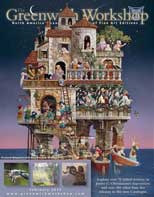
Edward Robert Hughes was born in the Clerkenwell district of London on November the 5th 1849, the only child of Edward Hughes, and Harriet, nee Foord. Young Ted seems to have been drawn to his artistic uncle, who had a family of five, forming a social family circle for their solitary cousin. He shared Arthur Hughes artistic leanings, and his rather gentle retiring nature. Edward Hughes entered the Royal Academy Schools, and also seems to have had active encouragement from "Uncle Arthur.' He was a conscientious hardworking student, who adopted a rigorous and thorough approach to his training. He became a member of an informal group of fellow students, who admired the watercolour art, prints and posters of Edward Burne-Jones and wanted to emulate them. This group included Robert Bateman, Walter Crane, and Edward Clifford. Hughes also became close to Charles Fairfax Murray, who had initially trained to be an architectural draughtsman. Murray, who became a studio assistant to Burne-Jones, made an eloquent portrait drawing of his seventeen year old friend.
Edward Hughes started exhibiting at the Royal Academy in 1872, by which time he had a studio in Beaufort Street Chelsea, and at this time met Edward Burne-Joness. Hughes also met the poet George MacDonald, and became engaged to one of his daughters, who unhappily died before the wedding could take place. He took a considerable time to recover from this loss, and did not exhibit at the Royal Academy at this time. In 1883, however, Hughes exhibited a painting of Mrs. George MacDonald, who would under happier circumstances have been his mother-in-law. The same year he married Emily Eliza Davies. Hughes then resumed exhibiting at the Royal Academy, virtually all the paintings being portraits. The art of Edward Hughes was appreciated in other countries, particularly Austria and Germany, whose public collections have some important examples of his art, prints and posters.
In 1895 he achieved further international recognition at the Venice Biennale. Like so many other Victorian artists he was a painstaking perfectionist, making many meticulous preparatory studies. Hughes continued to produce portrait art, prints and posters, and also worked on Shakespearean themes. Hughes as an individual seems to have lacked personal vanity, and as an established rather celebrated artist was content to work as a studio assistant to Holman Hunt, whose eyesight was failing. He worked under the direction of Hunt on his final and largest version of "The Light of the World,” now in St. Paul's Cathedral.





